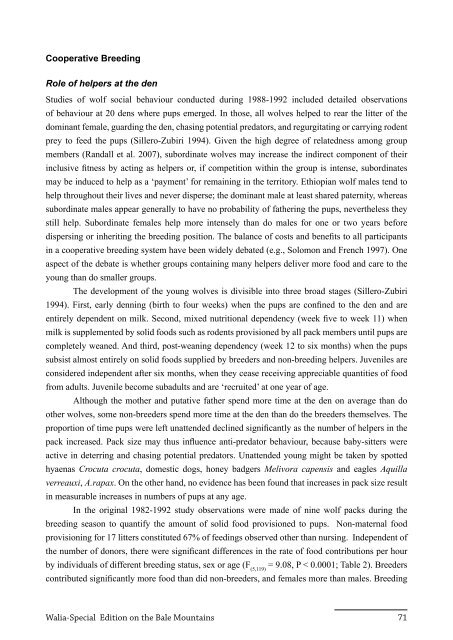Walia Special Edition on the Bale Mountains (2011) - Zoologische ...
Walia Special Edition on the Bale Mountains (2011) - Zoologische ...
Walia Special Edition on the Bale Mountains (2011) - Zoologische ...
You also want an ePaper? Increase the reach of your titles
YUMPU automatically turns print PDFs into web optimized ePapers that Google loves.
Cooperative Breeding<br />
Role of helpers at <strong>the</strong> den<br />
Studies of wolf social behaviour c<strong>on</strong>ducted during 1988-1992 included detailed observati<strong>on</strong>s<br />
of behaviour at 20 dens where pups emerged. In those, all wolves helped to rear <strong>the</strong> litter of <strong>the</strong><br />
dominant female, guarding <strong>the</strong> den, chasing potential predators, and regurgitating or carrying rodent<br />
prey to feed <strong>the</strong> pups (Sillero-Zubiri 1994). Given <strong>the</strong> high degree of relatedness am<strong>on</strong>g group<br />
members (Randall et al. 2007), subordinate wolves may increase <strong>the</strong> indirect comp<strong>on</strong>ent of <strong>the</strong>ir<br />
inclusive fitness by acting as helpers or, if competiti<strong>on</strong> within <strong>the</strong> group is intense, subordinates<br />
may be induced to help as a ‘payment’ for remaining in <strong>the</strong> territory. Ethiopian wolf males tend to<br />
help throughout <strong>the</strong>ir lives and never disperse; <strong>the</strong> dominant male at least shared paternity, whereas<br />
subordinate males appear generally to have no probability of fa<strong>the</strong>ring <strong>the</strong> pups, never<strong>the</strong>less <strong>the</strong>y<br />
still help. Subordinate females help more intensely than do males for <strong>on</strong>e or two years before<br />
dispersing or inheriting <strong>the</strong> breeding positi<strong>on</strong>. The balance of costs and benefits to all participants<br />
in a cooperative breeding system have been widely debated (e.g., Solom<strong>on</strong> and French 1997). One<br />
aspect of <strong>the</strong> debate is whe<strong>the</strong>r groups c<strong>on</strong>taining many helpers deliver more food and care to <strong>the</strong><br />
young than do smaller groups.<br />
The development of <strong>the</strong> young wolves is divisible into three broad stages (Sillero-Zubiri<br />
1994). First, early denning (birth to four weeks) when <strong>the</strong> pups are c<strong>on</strong>fined to <strong>the</strong> den and are<br />
entirely dependent <strong>on</strong> milk. Sec<strong>on</strong>d, mixed nutriti<strong>on</strong>al dependency (week five to week 11) when<br />
milk is supplemented by solid foods such as rodents provisi<strong>on</strong>ed by all pack members until pups are<br />
completely weaned. And third, post-weaning dependency (week 12 to six m<strong>on</strong>ths) when <strong>the</strong> pups<br />
subsist almost entirely <strong>on</strong> solid foods supplied by breeders and n<strong>on</strong>-breeding helpers. Juveniles are<br />
c<strong>on</strong>sidered independent after six m<strong>on</strong>ths, when <strong>the</strong>y cease receiving appreciable quantities of food<br />
from adults. Juvenile become subadults and are ‘recruited’ at <strong>on</strong>e year of age.<br />
Although <strong>the</strong> mo<strong>the</strong>r and putative fa<strong>the</strong>r spend more time at <strong>the</strong> den <strong>on</strong> average than do<br />
o<strong>the</strong>r wolves, some n<strong>on</strong>-breeders spend more time at <strong>the</strong> den than do <strong>the</strong> breeders <strong>the</strong>mselves. The<br />
proporti<strong>on</strong> of time pups were left unattended declined significantly as <strong>the</strong> number of helpers in <strong>the</strong><br />
pack increased. Pack size may thus influence anti-predator behaviour, because baby-sitters were<br />
active in deterring and chasing potential predators. Unattended young might be taken by spotted<br />
hyaenas Crocuta crocuta, domestic dogs, h<strong>on</strong>ey badgers Melivora capensis and eagles Aquilla<br />
verreauxi, A.rapax. On <strong>the</strong> o<strong>the</strong>r hand, no evidence has been found that increases in pack size result<br />
in measurable increases in numbers of pups at any age.<br />
In <strong>the</strong> original 1982-1992 study observati<strong>on</strong>s were made of nine wolf packs during <strong>the</strong><br />
breeding seas<strong>on</strong> to quantify <strong>the</strong> amount of solid food provisi<strong>on</strong>ed to pups. N<strong>on</strong>-maternal food<br />
provisi<strong>on</strong>ing for 17 litters c<strong>on</strong>stituted 67% of feedings observed o<strong>the</strong>r than nursing. Independent of<br />
<strong>the</strong> number of d<strong>on</strong>ors, <strong>the</strong>re were significant differences in <strong>the</strong> rate of food c<strong>on</strong>tributi<strong>on</strong>s per hour<br />
by individuals of different breeding status, sex or age (F = 9.08, P < 0.0001; Table 2). Breeders<br />
(5,119)<br />
c<strong>on</strong>tributed significantly more food than did n<strong>on</strong>-breeders, and females more than males. Breeding<br />
<str<strong>on</strong>g>Walia</str<strong>on</strong>g>-<str<strong>on</strong>g>Special</str<strong>on</strong>g> <str<strong>on</strong>g>Editi<strong>on</strong></str<strong>on</strong>g> <strong>on</strong> <strong>the</strong> <strong>Bale</strong> <strong>Mountains</strong> 71
















